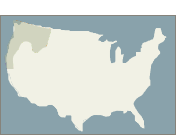Tribes: Pacific Northwest


Quinault Indian Nation Relocation, Managed Retreat, and Protection in Place Efforts
On the Olympic Peninsula of Washington, right along the Pacific Coast, are the present-day boundaries of the Quinault Reservation, owned by the Quinault Indian Nation (QIN). Natural hazards, intensified by climate change,
are putting QIN at risk of sinking below sea level as the land erodes and is flooded from multiple sources. Heavier rainfall events upstream and smaller snowpacks are causing riverine flooding on the Quinault and Queets
Rivers, exacerbating riverine erosion throughout QIN. Some of the most at-risk communities in QIN are only 7’ above sea level. Eroding riverbanks and cliffsides increases the frequency of landslides, which impacts roads
throughout the community. In addition, climate change is causing sea levels to rise at a rate of approximately 1 inch every 5 years, putting QIN at risk of not only riverine flooding, but coastal flooding and worsening
coastal and cliffside erosion.
The Quinault region is abundant in wetlands, which are wonderfully diverse ecosystems where many traditionally significant plant species grow, including sweet grass, camas lily, and beargrass. These wetlands are essential
for maintaining fish runs, the streams and tributaries that lead fish from spawning grounds to the ocean, which ensures abundant access to traditional foods. While these wetlands provide countless ecosystem services to
Quinault, they too are beginning to pose a flooding risk as manmade structures, such as roads and sea walls, prevent adequate drainage. Meanwhile, multiple communities in QIN are at risk of being submerged and washed into
the Pacific. While flooding and erosion will continue to increase in severity over time with climate change, QIN is also threatened by tsunamis and earthquakes, a persistent threat in the Pacific Northwest. QIN would have
little to no warning when one of these catastrophic events hit, as these events are scientifically unpredictable. The Village of Taholah may have as few as 10 minutes to evacuate in the event of an earthquake in the
Cascadia Subduction Zone, which would cause a tsunami.
Given the natural hazards QIN faces and the understanding that they will intensify given climate change, in 2012 QIN made the commitment to pursue community relocation by beginning the development of their Relocation
Master Plan, which was finalized in 2017. Their plan is to relocate two villages – the Village of Taholah and the Village of Queets. The Relocation Master Plan details land uses, development standards, and the location
and design of public buildings and facilities that will be constructed at the new sites. It is an essential guiding document for QIN’s relocation efforts and serves as an example for other communities considering and
undergoing relocation, managed retreat, and protect-in-place planning processes.
Communities across the world are facing climate-induced threats, including changing weather patterns, natural hazards, and subsequent changes to the landscape. For some, these threats are so severe that their communities
are looking to pursue large scale relocation, managed retreat, and protection-in-place (RMP) efforts. Protection-in-place is typically the first option communities pursue and involves constructing shoreline protection
measures, such as sea walls or berms, to minimize impacts of coastal hazards. These protections allow the community to remain in their current location, but cost millions of dollars, require help from engineers, and are
not failsafe. Managed retreat is a smaller scale relocation, wherein only a portion of the community – often the most vulnerable – move to a new location in the community, or to a location adjacent to the current site.
Within these RMP decisions, relocation is often the option of last resort, as it requires moving an entire community to a new location that is not connected to the existing site. Relocation is often the most expensive
of the RMP responses and requires acquiring new land off site – which can introduce legal battles to an already nuanced problem.
QIN is at different phases of relocation between the two villages – the lower Village of Taholah and the Village of Queets. The Queets Relocation Master Plan was recently completed, and engineering of Phase 1 for locations
of roads, utilities (water, sewer, power), and civic development including parks, homes, and government structures is in progress and will be completed in June 2025. The Taholah Relocation Master Plan was finalized in
2017, and Phase 1 infrastructure was completed in 2023. They have been awarded funding to conduct planning efforts of Phase 2 of the Taholah relocation, but in the meantime, the Quinault Housing Authority (QHA) is working
with QIN to determine the need of the threatened lower village community to be allocated land at the new site to construct low-income housing. They are currently constructing 6 homes at the new Taholah relocation site.
Although the relocation of Taholah is underway, QIN is still determining the best ways to convince community members in the lower village to relocate.
The word "relocation" carries a plethora of negative connotations for Tribal members. The legacy of forced relocations in the United States is still present through generational trauma and current reservation
boundaries – the same boundaries that some Tribes are now having to relocate from once again. However, QIN’s relocation sites are within the reservation boundaries and are close to the existing village sites. Because
of a history of forced relocations, the financial logistics of current relocation efforts, cultural connection to place, and more, relocating community members can be challenging. While some QIN Tribal members are
eager to relocate, others have not had a positive response to the plan. Most families residing in the threatened lower village site own their homes and find it stressful to consider acquiring a new mortgage in order
to relocate. At QIN, relocating is currently optional, though highly encouraged by the Tribal government. Despite this, a promising 75% of community members living in high-risk areas stated that they would be willing
to relocate, based on a QIN needs assessment.
This figure did not come without hard work from various Tribal staff at QIN, however. In the 12 years since QIN started developing their Relocation Master Plan, community members have been given opportunities to
ask questions, express their concerns, and provide input regarding Village relocation. QIN holds frequent community events updating the community on the progress of relocation. The secret to high turnout? Delicious
food. QIN provides a shared meal with all who attend these community events, and when possible, it’s something made with traditional ingredients – like a clam chowder or salmon dinner. These meetings have been
community driven and held for over a decade, and the continued discussions of relocation make it a more comfortable thought. They have met hostility about the subject with compassion and understanding, and as a
result, more QIN community members are open to the idea of relocating. The QIN Tribal government is working with Tribal community members to secure affordable housing for those eligible and ensuring that the most
vulnerable community members are relocating as soon as possible.
RMP efforts are unprecedented, and Tribal Nations pursuing them rarely have guidance on how to develop or execute RMP plans. Federal technical and financial support is severely lacking, often leaving Tribes to rely
on knowledge exchanges to determine how neighboring communities are making progress on their RMP plans resulting in a piece-meal process. QIN hopes to contribute to the research on RMP plans and efforts available
to Tribal communities, ultimately providing them direction and answers to some of the questions they’re having about RMP related issues unique to their respective communities. Although a nationwide, centralized
program dedicated to RMP planning would be invaluable to communities facing these decisions, continued inter-Tribal support networks are necessary to further this work now and into the future.
Relocating a village takes a village. While some communities are fortunate to have RMP Coordinators, including QIN, the work cannot be completed by one person alone. At QIN, there is a collective team of dedicated
staff, Tribal community members, and other individuals who all work on relocation within their respective full-time positions and see it as a major priority. Although capacity is scarce, joint efforts is what makes
their relocation plans possible. Ultimately, QIN wants Tribal residents to sleep soundly, knowing that they and their children are safe from major environmental catastrophes. Across the world, this common goal of
community safety and resilience is a connecting piece in RMP efforts. QIN is deeply appreciative of how many Tribal community members share this vision for relocation – not only with its own elected officials but
with other communities facing similar challenges. The investment from the QIN community is what makes this project possible.